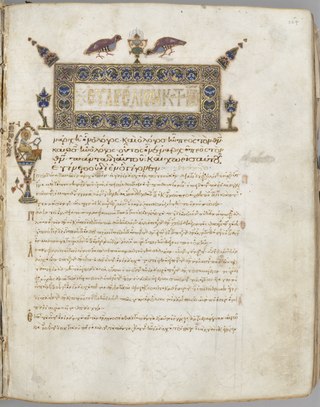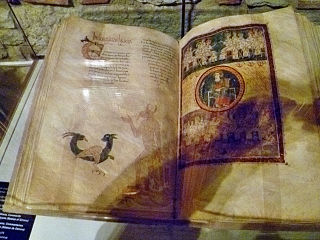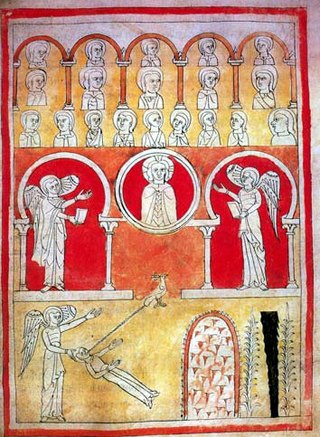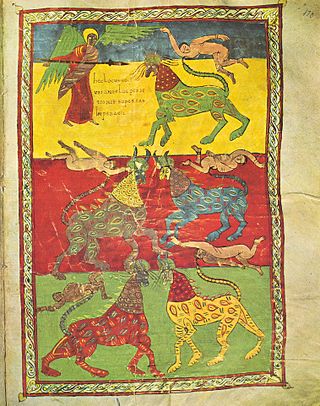
An illuminated manuscript is a formally prepared document where the text is decorated with flourishes such as borders and miniature illustrations. Illuminated manuscripts include liturgical books such as psalters, courtly literature, and documents such as proclamations.

The Book of Mulling or less commonly, Book of Moling, is an Irish pocket Gospel Book from the late 8th or early 9th century. The text collection includes the four Gospels, a liturgical service which includes the "Apostles' Creed", and in the colophon, a supposed plan of St. Moling's monastery enclosed by two concentric circles.

A miniature is a small illustration used to decorate an ancient or medieval illuminated manuscript; the simple illustrations of the early codices having been miniated or delineated with that pigment. The generally small scale of such medieval pictures has led to etymological confusion with minuteness and to its application to small paintings, especially portrait miniatures, which did however grow from the same tradition and at least initially used similar techniques.

Santo Domingo de Silos Abbey is a Benedictine monastery in the village of Santo Domingo de Silos in the southern part of Burgos Province in northern Spain. The monastery is named after the eleventh-century saint Dominic of Silos.

The Morgan Beatus is an illuminated manuscript with miniatures by the artist Magius of the Commentary on the Book of the Apocalypse by the eighth-century Spanish monk Beatus, which described the end of days and the Last Judgment. The book is believed to have been constructed in and around the scriptorium of San Miguel de Escalada in Spain. Having been created at some time in the 10th century, the Morgan Beatus is one of the oldest examples of a revived Spanish apocalypse tradition. According to the style it was created by Mozarabs. As one of the earliest works of Mozarabic art, the Morgan Beatus exemplifies the interworking connections between the Christian citizens of Spain under the Muslim Moorish leaders, especially in newly Arabicized areas such as Léon and Córdoba. The Apocalypse and the commentary on this scripture by Saint Beatus of Liébana became one of the most important religious texts of the Middle Ages, and was often illustrated very fully.

Armenian illuminated manuscripts, form an Armenian tradition of formally prepared documents where the text is often supplemented with flourishes such as borders and miniature illustrations. They are related to other forms of Medieval Armenian art, Persian miniatures, and to Byzantine illuminated manuscripts. The earliest surviving examples date back to the Golden Age of Armenian art and literature in the 5th century. Armenian illuminated manuscripts embody Armenian culture; they illustrate its spiritual and cultural values.

The Escorial Beatus is a 10th-century illuminated manuscript of the Commentary on the Apocalypse by Beatus of Liébana. The illuminations of the manuscript show similarities in style to those produced by Florentius, the artist responsible for a copy of the Moralia in Job of Pope Gregory I. The manuscript was probably created at the monastery at San Millán de la Cogolla. There are 151 extant folios which measure 395mm by 225mm. The manuscript is illustrated with 52 surviving miniatures.

Mozarabic art is an early medieval artistic style that is part of the pre-Romanesque style and is linked to the kingdom of León. It was developed by the Hispanic Christians who lived in Muslim territory and in the expansion territories of the León crown, in the period from the Muslim invasion (711) to the end of the 11th century. During this period, disciplines such as painting, goldsmithing and architecture with marked Caliphate influences were cultivated in a context of medieval coexistence - Christian, Hebrew and Muslim - in which the territories were constantly changing in size and status. Other names for this artistic style are Leonese art or repopulation art.

Commentary on the Apocalypse is a book written in the eighth century by the Spanish monk and theologian Beatus of Liébana (730–785) and copied and illustrated in manuscript in works called "Beati" during the 10th and 11th centuries AD. It is a commentary on the New Testament Apocalypse of John or Book of Revelation. It also refers to any manuscript copy of this work, especially any of the 27 illuminated copies that have survived. It is often referred to simply as the Beatus. The historical significance of the Commentary is made even more pronounced since it included a world map, which offers a rare insight into the geographical understanding of the post-Roman world. Well-known copies include the Morgan, the Saint-Sever, the Gerona, the Osma and the Madrid Beatus codices.

The Psalter of Oswald also called the Ramsey Psalter is an Anglo-Saxon illuminated psalter of the last quarter of the tenth century. Its script and decoration suggest that it was made at Winchester, but certain liturgical features have suggested that it was intended for use at the Benedictine monastery of Ramsey Abbey in Huntingdonshire, or for the personal use of Ramsey's founder St Oswald.

The Gerona Beatus is a 10th-century illuminated manuscript currently housed in the museum of Girona Cathedral, Catalonia, Spain.
M. Moleiro Editor is a publishing house specialising in high-quality facsimile reproductions of codices, maps and illuminated manuscripts. Founded in Barcelona in 1991, the firm has reproduced many masterpieces from the history of illumination.

The Urgell Beatus, Beatus d'Urgell or Beatus la Seu d'Urgell is a 10th-century illuminated manuscript and medieval commentary. It is at Musei Diocesá de La Seu d'Urgell, at La Seu d'Urgell in Spain.

The Westminster Psalter, British Library, MS Royal 2 A XXII, is an English illuminated psalter of about 1200, with some extra sheets with tinted drawings added around 1250. It is the oldest surviving psalter used at Westminster Abbey, and is presumed to have left Westminster after the Dissolution of the Monasteries. It joined the Old Royal Library as part of the collection of John Theyer, bought by Charles II of England in 1678. Both campaigns of decoration, both the illuminations of the original and the interpolated full-page drawings, are important examples of English manuscript painting from their respective periods.

The Apocalypse of Lorvão is an illuminated manuscript from Lorvão, Portugal containing the Commentary on the Apocalypse of Beatus of Liébana Monastery, Spain.

The Beato of Valcavado is an illuminated manuscript—copies of the Commentary on the Apocalypse of Saint John of Beatus of Liébana—copied by a monk called Oveco in the year 970, in the now-vanished Our Lady of Valcavado monastery in Palencia. It is held in the collection of the Santa Cruz Palace.

The Tábara Beatus or Beatus of Tábara is a 10th-century illuminated manuscript, containing the Commentary on the Apocalypse by Beatus of Liébana. It originated in the San Salvador de Tábara Monastery and is now held in Spain's National Historical Archive in Madrid under the catalogue number L.1097B. Only eight of its original hundred miniatures survive.

The León Bible of 960 or Codex Biblicus Legionensis is a mozarabic Bible manuscript copied and illuminated in 960 at the monastery of Valeránica in Tordómar. It is now held in the library of the Basílica de San Isidoro, León - why it moved there is unknown, though the monastery in which it was produced disappeared at the end of the 10th century and so it could have been given to the Basilica during the 11th century by Ferdinand I of Leon and his wife Sancha, the main patrons of the basilica.

The Birds' Head Haggadah is the oldest surviving illuminated Ashkenazi Passover Haggadah. The manuscript, produced in the Upper Rhine region of Southern Germany in the early 14th century, contains the full Hebrew text of the Haggadah, a ritual text recounting the story of Passover – the liberation of the Israelites from slavery in ancient Egypt – which is recited by participants at a Passover Seder. The text is executed in block calligraphy and accompanied by colorful illustrations of Jews performing the Seder practices and reenacting Jewish historical events. The Birds' Head Haggadah is so called because all Jewish men, women, and children depicted in the manuscript have human bodies with the faces and beaks of birds. Non-Jewish and non-human faces are blank or blurred. Numerous theories have been advanced to explain the unusual iconography, usually tied to Jewish aniconism. The Haggadah is in the possession of the Israel Museum in Jerusalem, where it is on permanent exhibition.

The Golden Haggadah is an illuminated Hebrew manuscript originating around c. 1320–1330 in Catalonia. It is an example of an Illustrated Haggadah, a religious text for Jewish Passover. It contains many lavish illustrations in the High Gothic style with Italianate influence, and is perhaps one of the most distinguished illustrated manuscripts created in Spain. The Golden Haggadah is now in the British Library and can be fully viewed as part of their Digitized Manuscript Collection MS 27210.


















